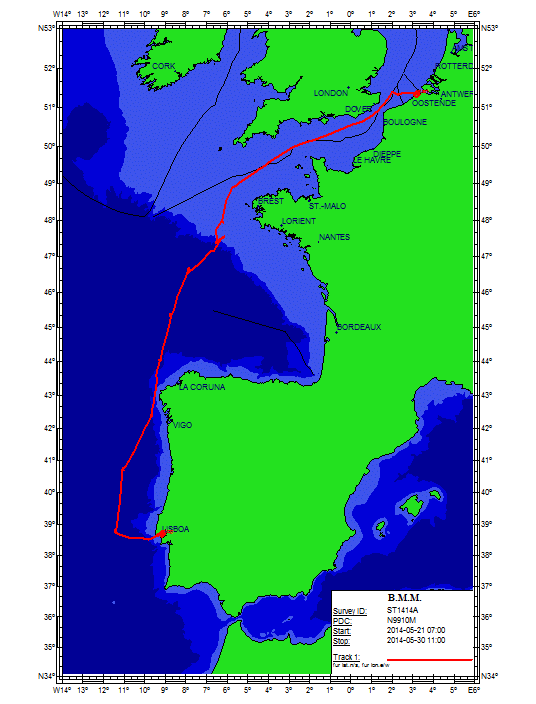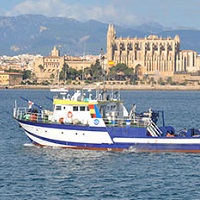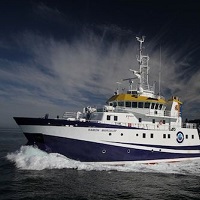Keyword
Carbon concentrations in suspended particulate material
17 record(s)
Type of resources
Categories
Topics
INSPIRE themes
Keywords
Contact for the resource
Provided by
Years
Formats
Status
-

The research programme of Belgica campaign 2014/14 aimed at assessing the different biogeochemical processes controlling the carbon and nitrogen cycles in oligotrophic N.E. Atlantic waters. These cycles are essential components of the biological Carbon Pump' by which part of atmospheric carbon dioxide is transferred to the ocean's interior. Our approach is based on the use of dual nitrate isotope measurements (natural abundance and enrichment experiments) to disentangle these various nitrogen processes in the marine environment, and in particular the process of diazotrophy by which atmospheric N2 is introduced into the oceanic fixed nitrogen reservoir. This input of new' nitrogen should stand in balance with the denitrification process by which nitrogen is lost from the oceanic system. There are indications that the intensity as well as the geographical distribution of diazotrophic activity has been underestimated till date, in general. It is of particular interest to better document diazotrophic activity at latitudes of 38°N and northward, areas for which only few data are available. During the cruise we studied the different biogeochemical processes acting on the marine N-cycle, including N2 fixation, nitrate (NO3-), ammonium (NH4+) and nitrite (NO2-) uptake, nitrification, along a north-south section through the Gulf of Biscaye to Cape Finisterre and further south in open ocean waters along the Iberian peninsula till about 38°30'N. In addition, the effect of iron limitation on the nitrogen fixation and the nitrification processes was investigated.
-

Determinación de las variaciones diarias en la dieta de larvas de sardina
-

The objective of the DOS MARES project is twofold. First, we aim at understanding the effects of the atmospheric teleconnections between the Cantabrian Sea and the north-western Mediterranean Sea, and their impacts on the deep ecosystem, both pelagic and benthic. Second, we want to know in which way the transfer of the signal from the external forcings towards the deep ecosystem controls the community structure and the population dynamics. Thus, in March 2012 we deployed 6 mooring lines equipped with sediment traps and currentmeters in the Avilés and Gaviera canyons and the slope. In September 2012 the moorings were successfully recovered and redeployed again, and during this cruise DOSMARES BIOCANT3 they have been finally recovered and the 1-year monitoring effort finalised. In addition, CTD profiling has been performed to characterise the biological and physical structure of the water column (including the acquisition of discrete water samples), multicorers have been obtained to characterise the geochemical properties of surface sediments, and a multinet used to obtain macro- and meso-zooplankton community structure. Overall, data will allow to characterize the external forcings and abiotic conditions in the Cantabrian Sea, and thus establish the links between abiotic conditions, populations and pelagic and benthopelagic resources.
-

The objective of the DOS MARES project is twofold. First, we aim at understanding the effects of the atmospheric teleconnections between the Cantabrian Sea and the north-western Mediterranean Sea, and their impacts on the deep ecosystem, both pelagic and benthic. Second, we want to know in which way the transfer of the signal from the external forcings towards the deep ecosystem controls the community structure and the population dynamics. Thus, in March 2012 we deployed 6 mooring lines equipped with sediment traps and currentmeters in the Avilés and Gaviera canyons and the slope. In September 2012 the moorings were successfully recovered and redeployed again, and during this cruise DOSMARES BIOCANT3 they have been finally recovered and the 1-year monitoring effort finalised. In addition, CTD profiling has been performed to characterise the biological and physical structure of the water column (including the acquisition of discrete water samples), multicorers have been obtained to characterise the geochemical properties of surface sediments, and a multinet used to obtain macro- and meso-zooplankton community structure. Overall, data will allow to characterize the external forcings and abiotic conditions in the Cantabrian Sea, and thus establish the links between abiotic conditions, populations and pelagic and benthopelagic resources.
-

Multidisciplinary campaing for mooring instruments and adquiring samples and variables to: * Know the thermohaline, kinematic, dynamic and biological characteristics of the Gulf of Cadiz. * Study of carbon fluxes between the Atlantic and Mediterranean. * Linking climatology, hydrology and hydrodynamics and the early stages of development of the species associated with the platform, with a focus on species of fishing interest. * Provide data to feed global and regional numerical models. * Generate and distribute a database to know the evolution of marine climate and its resources.
-

Multidisciplinary campaing for mooring instruments and adquiring samples and variables to: * Know the thermohaline, kinematic, dynamic and biological characteristics of the Gulf of Cadiz. * Study of carbon fluxes between the Atlantic and Mediterranean. * Linking climatology, hydrology and hydrodynamics and the early stages of development of the species associated with the platform, with a focus on species of fishing interest. * Provide data to feed global and regional numerical models. * Generate and distribute a database to know the evolution of marine climate and its resources.
-

Multidisciplinary campaing for mooring instruments and adquiring samples and variables to: * Know the thermohaline, kinematic, dynamic and biological characteristics of the Gulf of Cadiz. * Study of carbon fluxes between the Atlantic and Mediterranean. * Linking climatology, hydrology and hydrodynamics and the early stages of development of the species associated with the platform, with a focus on species of fishing interest. * Provide data to feed global and regional numerical models. * Generate and distribute a database to know the evolution of marine climate and its resources.
-

Multidisciplinary campaing for mooring instruments and adquiring samples and variables to: * Know the thermohaline, kinematic, dynamic and biological characteristics of the Gulf of Cadiz. * Study of carbon fluxes between the Atlantic and Mediterranean. * Linking climatology, hydrology and hydrodynamics and the early stages of development of the species associated with the platform, with a focus on species of fishing interest. * Provide data to feed global and regional numerical models. * Generate and distribute a database to know the evolution of marine climate and its resources.
-

The EU funded MIDAS RTD project (7th FP, gran agreement 603418) overarching objective is to determine the impact of deep-sea mining on deep marine ecosystems. To investigate the behaviour and the effects of heavy metal rich resuspended sediment plumes over benthic organisms and ecosystems, the University of Barcelona coordinates a plume generation and monitoring experiment in the bay of Portman, SE of Spain, where millions of tones of metal rich mine tails from onshore mines were dumped from 1957 to 1990. Prior to the seafloor disturbance experiment to generate the plumes, a careful mapping of the study area, and in particular of the area covered by the mine tails deposit was carried out. Two vessels are used for the disturbance experiment. The first vessel generates the plumes by bottom trawling, while the second one monitors the plume evolution through time with a variety of sensors, including acoustics. Moorings with sediment traps, current-meters, mussel ropes and baited traps are deployed in and around the seafloor area disturbed by the trawler.
-

Background and Aims MEDWAVES The Strait of Gibraltar (SG) and the surrounding areas, Gulf of Cadiz (GoC) in the Atlantic, and Alboran sea (AS) in the Mediterranean, are key areas to understand the distribution and connectivity of marine communities (Patarnello et al. 2007), as the SG and the encounter of water masses at the Almeria Oran front represent an oceanographic transition area, connecting the Atlantic Ocean and the Mediterranean Sea (Lacombe & Richez 1982). The Mediterranean water flows out from Gibraltar (MOW), extends towards the East of the Atlantic, building a warm and salty water mass which propagates in North West direction from Portugal originating the “Mediterranean Water“ (MW) in the Atlantic. This warm and salty water mass becomes characteristic of the North Atlantic in mid waters (around 1100 m) (Candela 2001). The occurrence of cold-water coral (CWC) communities in the NE Atlantic has been related to the pathway of the MOW, whereby this current system would have an historical influence on the migration of coral larvae and (re)colonization of the Atlantic in the post-glacial era (De Mol et al. 2005, Henry et al. 2014). The MEDWAVES (MEDiterranean out flow WAter and Vulnerable EcosystemS) cruise target areas under the potential influence of the MOW within the Mediterranean and Atlantic realms. These include seamounts where CWC have been reported but that are still poorly known, and which may act as essential “stepping stones” connecting fauna of seamounts in the Mediterranean with those of the continental shelf of Portugal, the Azores and the Mid-Atlantic Ridge. During MEDWAVES sampling will be conducted through two of the case studies of ATLAS: Case study 7 (Gulf of Cadiz-Strait of Gibraltar-Alboran Sea) and Case study 8 (Azores). The main goals of the cruise are: (1) to characterize physically and biogeochemically the MOW Path and understand its interaction with the general Atlantic Meridional Overturning Circulation (AMOC) stream, from the Alboran Sea to the Azores, through the Gulf of Cadiz, and the Ormonde Seamount (see map), exploring the relationship between the oceanographic settings of these target areas and the ecosystems therein (ATLAS WP1 and WP3) and (2) to characterize communities associated to the transition area, and sample for population genetic analysis aiming at understanding the way the populations located in the target areas contribute or have contributed to connectivity between the Mediterranean Sea and the Atlantic Ocean (ATLAS WP3 and WP4). Results gathered during the cruise will also contribute later to feed other ATLAS WPs. The activities planned to achieve these aims are presented in the brief description of the work program of the different research teams participating in ATLAS (Work program of the research teams).
 Catálogo de datos del IEO
Catálogo de datos del IEO